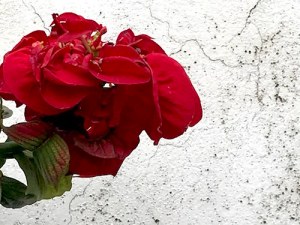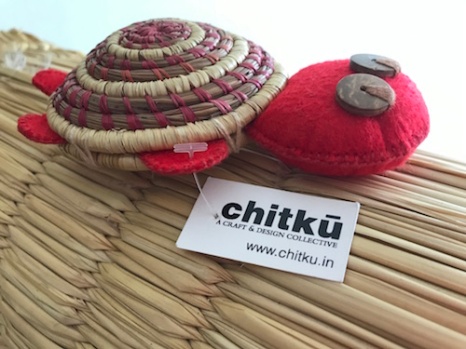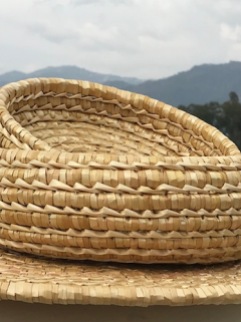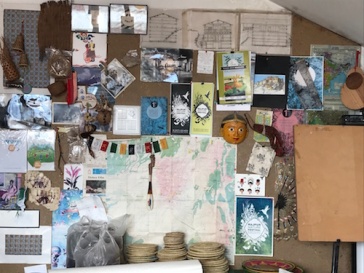Hi, I’m Chitku 🙂 we’ve met before. This is my brother Kaachbo.
We have been brought into this world by Priyanka Tolia. She is an Exhibition Designer from the National Institute of Design (NID), Ahmedabad, and had studied History (Honours) from Lady Shri Ram College (LSR) before that. Priyanka often heard from the elders in her community of how when they led the transhumance trading lives before the 1962 war with China, as kids they were asked to ‘go play chitku’ , which essentially meant a place where children were sent out to play. It was also the place where the young ones, under the guidance of the older girls and boys, playfully picked up skills of spinning and plying wools yarns and other textile arts. It’s an endearing term for her 🙂
And, Kaachbo is the name given by Priyanka’s faculty from NID, designer Suranjana Satwaleker. When Suranjana met my brother, she immediately remembered her Indian star tortoise from her childhood whom she had rescued. We are both created out of immense love – how lucky are we!
Hello world, from Chitku and Kaachbo – today, we will tell you our story…![]()
 Uttarakhand was carved out as a new state from Uttar Pradesh in the year 2000. The other two states formed in that year were Jharkhand and Chattisgarh. She learnt of exciting work taking place in her new home state across varied sectors through her NID senior Richa Ghansiyal and batchmate Usha Prajapati, who had joined as designers to work with UBFDB – Uttarakhand Bamboo and Fibre Development Board. The creation of UBFDB itself was an outcome of long interactions with MP Ranjan, India’s foremost Design Thinker, senior designer and faculty at NID.
Uttarakhand was carved out as a new state from Uttar Pradesh in the year 2000. The other two states formed in that year were Jharkhand and Chattisgarh. She learnt of exciting work taking place in her new home state across varied sectors through her NID senior Richa Ghansiyal and batchmate Usha Prajapati, who had joined as designers to work with UBFDB – Uttarakhand Bamboo and Fibre Development Board. The creation of UBFDB itself was an outcome of long interactions with MP Ranjan, India’s foremost Design Thinker, senior designer and faculty at NID.
Around 2003, while working in Mumbai, many of her colleagues from varied Himalayan states of India, discussed frequently and naively on the needs of design interventions to create livelihood opportunities so as to push mountain industries that otherwise face isolation. They dreamt of opening design studios from where they could work and expand on the Indian Designscape – bringing forth the unique mountain lifestyles and philosophies on materials and form. For them, several seniors like Peter Marbiang and Richa had already set precedence. Their Alma mater, NID, of course, over the years had already impressed and moulded their minds through its various engagements in projects such as Bamboo Boards and North East projects in publication and product development. The Uttarakhand state logo was designed by NID Graphic Design Team.
Finally, Priyanka left Mumbai in 2009. The shift was not just from a metropolitan centre to a hill town, but professionally it meant a shift from a commercially driven private sector to a socially driven development sector, where there was a need to understand the social cultural milieu in which majority of the rural areas operate, and mountain issues are unique by itself. This prompted her to dive in projects at field where travels and visits to remote destinations was the best way to grasp the context in which mountain lifestyle and livelihoods are based on. In her absence from home for her studies and employment, Uttarakhand had been formed – so she found a new political entity on her return! Exciting?!!!
 She was introduced to a range of indigenous materials and ingenuous craft techniques and skills unique to the Himalayan range and its foothills. Not specifically trained to operate within the crafts sector, she gradually took up crafts research and documentation projects, training workshops in varied materials and closely worked with NGO’s in varied capacities. Against this backdrop, began her close dialogue and discussion with associates in the same field of mountain development and strategies – Richa, Sonam Tashi and Sucharita Beniwal.
She was introduced to a range of indigenous materials and ingenuous craft techniques and skills unique to the Himalayan range and its foothills. Not specifically trained to operate within the crafts sector, she gradually took up crafts research and documentation projects, training workshops in varied materials and closely worked with NGO’s in varied capacities. Against this backdrop, began her close dialogue and discussion with associates in the same field of mountain development and strategies – Richa, Sonam Tashi and Sucharita Beniwal.
Richa has been dedicatedly working with the crafts sector since more than two decades and now also owns the fantastic ‘The Tea Room’ at their Studio Alaya with her husband Jo. The Studio has been creating unique design solutions for interiors for more than 10 years. But The Tea Room is very new, very beautiful and full of yummy delicacies.
While Richa and Priyanka engage in deep design and craft discussions, figure out ways of working through recent challenges like packaging of breakable products, let’s gloat over some of the food you have to gorge on when you’re there next: local cuisine of mutton keema, potato (bread), aloo – puri (potatoes and deep fried flour bread), hot chocolate and eclairs. Yes, Dehradun has some awesome confectionaries and Richa has personally trained her young culinary team!
Let’s rewind to 2009. Priyanka engages in her first product development and training programme in Grewia optiva (Bhimal) with the women artisans from Mangroli and Udham Singh Nagar. This is the first time she interacts and learns from Garhwali Shauka and Tharu Tribes . Don’t forget these Tharu women, our story is mainly about them – though Kaachbo and I didn’t exist then!
This sets the first small step in her establishing herself and learning about her home state. Priyanka’s from up the mountains, in picturesque but difficult-to-reach Munsyari, 2200 mt above sea level, in Pithoragarh district. Her dreams are as pure and lovely as her home 🙂 have you been there yet?

After the research and documentation of Jaunsar valley architecture, she undertook the research, product development and training programme in Pine Needles, a forest waste resource, with her Tharu artisans for a eco-tourism company called Due North. Her friend Usha was designer and project head here. Thereafter, in collaboration with Deepthi Radhakrishan she takes up the responsibility of designing promotional and souvenir design for the tribal festival, Rungkangdali, at the Indo – Nepal border region of Dharchula. Here, she gets the opportunity to hone her marketing skills with the rural entrepreneurs of Dharchula. Phew… so much research and work done in such short time! But you wouldn’t get anywhere without such microcosmic level, dedicated work.
In 2012, Priyanka began the Museum Design project for the Rung Kalyan Sansthan (RKS) at Dharchula. The project had NIDians Sandeep Raj K and Apurva as diploma and intern students for 6 and 2 months respectively. Over the years, through the research and concept development for preparation of a blueprint for the Museum, she met with several weavers’ groups and crafts communities. Their stories, lifestyles, occupations, social structures, heritage traditions, rituals, religious beliefs, recreations, and objects related to these form the core of the Museum. Btw, the first and major phase of the Museum Design is over, it is open to public.
Slowly, we are inching towards our creation…
 In the photograph, the woman at the bottom is Sunheri and above her is Mukesha – both from Pindari village, and on top is Susheela, from Painpura, all in Udham Singh Nagar district. They are the last of the Tharu indigenous people who have a wide range of skill set and knowledge on wild grass and natural materials.
In the photograph, the woman at the bottom is Sunheri and above her is Mukesha – both from Pindari village, and on top is Susheela, from Painpura, all in Udham Singh Nagar district. They are the last of the Tharu indigenous people who have a wide range of skill set and knowledge on wild grass and natural materials.
Together, with Priyanka, they conceived fairies and tortoises like Kaachbo and me 🙂
Oh these photo bombers! :p
In the course of her primary research trips, Priyanka was fascinated by the crafts made out of the Himalayan forest resources. Pine Needles, wild grass and nettle were traditionally used to make utilitarian products like baskets, mats, ropes, beds (charpais) of ropes. These were eco – friendly, organic, sustainable, revenue generating, design solutions for the local population but due to the laborious process of extraction of raw materials and preparation of the final production, these crafts were gradually phasing out. Why not? There were cheaper, longer lasting, plastic alternatives around. In bright and shiny colours. From cities. Those are quite tempting.

Priyanka found her ‘mojo’ – the purpose of her return to her native land seemed to find some form. It was still a distant dream but one that seemed achievable. She started focussing more and more on research and documentation of local resources and traditional knowledge for designing products and services for clients working in the field of sustainable mountain development issues. This would enable creation of livelihood and employment opportunities.
Let’s now talk about the Tharu community from Udham Singh Nagar. The women are barely literate, mostly studied till primary school, usually busy with their agricultural and household duties. They collect wild grass (13 varieties!) from riverbeds just after the monsoons, stock them and after sowing the harvest they weave baskets in their spare time in non-farming seasons. Being in a joint family, the women shared responsibilities as in daily house chores as men were engrossed in rigorous agricultural activities.
After their 40s most artisans could not weave baskets due to failing eyesight. Due to an increase in nuclear families, women now have no one to share their household work with (including livestock that needed tending to) hence they were turning to more practical products that suited their needs. The younger generation was rapidly losing interest in these traditional crafts.
The main source of income for the Thaaru is agriculture. They worked hard in the fields and lived off their produce, if there was surplus they would sell it off. Simple people with simple needs.
But with time, needs changed. Young Tharu people have more aspirations. More educated than their fathers, they moved into bigger cities with jobs and needed their parents to have, amongst other modern day necessities, mobile phones to keep in touch. Meagre agricultural income was not proving enough for them. Medical needs were increasing. Central government schemes like MNREGA was bringing in more earnings for 8 hours of work then they had envisaged so now they were ready to explore other options for income. The time was somewhat ripe for Priyanka to invest in.
That’s when Priyanka wrote in the mission statement for her Design Studio Chitku – a design and craft collaborative:
“keep our craft practices relevant by designing products for contemporary lifestyles by intervening and adding basic innovations in material and techniques. We strive to conceive and create our products from indigenous materials and skills and hope it can present the best of contemporary Uttarakhand, and thus maybe, add our bit to the Indian Design Vocabulary.”
Chitku Design Studio experiments with colours, textures, forms resulting in exciting designs. What do you think? Check these photos.
These are just some examples made by Tharu women for Chitku (yes, that’s where I get my name from – blush, blush, blush…). I’ll try to explain the process. Tharu women collect wild grass like kausi, panheri, munj and gondi from riverbeds, they let them dry, clean them, thrash them, sort them out according to their quality, size and colour. Then the artisan leaders like Mukesha come to Dehradun to the Chitku studio where they sit with Priyanka and make prototypes of varies products. They bring a little bit of the grass for making samples, rest they leave in their homes.
Priyanka discusses with them the challenges in the new designs and products, which women will be able to do what, where each artisans interests lie. She insists that everyone enjoys the process and feel a part of it and would never impose a design or product that the community felt was alien to their sensibility. During these dialogues, usually spattered with lots of gossip and giggles, she keeps pushing them to explore more and extend their known territories. She personally draws out each design. Once, the leaders grasp what’s to be done, they decide which women back in their villages would do what. Duties and timelines are duly assigned. And, the gossip continues 🙂
Toys, plates, storage baskets, floor cushions, Christmas decorations, paperweights (Kaachbo is one) are made from wild grass.
That’s how I was also made.
First, Priyanka dreamt of someone like me. A fairy. Then she drew my form out. After explaining to her team, they went about realising me. They collected lots of good quality grass, dyed them into an attractive colour, found wooden beads for my head and corn husk for my hair. Priyanka cut out my form into hard cardboard and her team lovingly wove the wild grass with bright wool. I have bells, I tinkle. Kaachbo just lies around, he’s a paper weight. But I was given wings. I fly 🙂
Here I am, this is me 🙂 (thank you Bryan Adams)

Priyanka has been working on other craft initiatives like developing new products with Himalayan Nettle. It is very difficult to extract nettle from the plant and convert into fibre. There are multiple stages of boiling, beating, carding, combing, spinning and finally weaving. There’s still so little understanding of nettle fibre textiles that they are hardly sought after in India, though much in demand in the Western world. The studio is not always able to cater to such a high demand as the production process is laborious and thus capital intensive. The weather plays a key role in the mountains.
A strong believer of open source, collaborations and resource sharing, Priyanka has worked with Karma Sonam of Kuzu, Sikkim, for nettle products and Sonam of La and EchoStream for bamboo. Many many more of them, like Usha, Jisha Unnikirishnan, KungaTashiLepcha and Bhavneet Kaur, came together to produce the first ever comprehensive compilation of the crafts of Uttarakhand, a book of the same name. Do buy a copy asap, if you haven’t… It’s drool worthy and educational, available on Amazon.
So you have patiently heard my story, my family’s story – including everyone who made me. From designers, government officials, crafts communities, local resources, crafts bazaars, Indian and foreign stores. But you know who’s the most important person in my family? YOU 🙂 Yes, we exist because of you, for you. Make us your own.
Priyanka Tolia is extremely grateful to NID, her faculty, the workshop ‘kakas’, all the staff, and her friends from there including Misha Gurnanee, Sujay Narayan, Palzor Bhutia, Tenzing, Ranveer Singh (to just name a few) 🙂
ps. Chitku products are not yet available online, however if you are interested then please dm at varnikadesigns@Instagram or Facebook.
All photos taken by the author at the Chitku Design Studio, Dehradun, January 2019. Videos available at varnikadesigns@Instagram












































Such an inspiring story! Thanks for sharing Poulomi! 🙂
LikeLike
Thank you Nidhi, glad you liked it 🙂 Priyanka Tolia and her team are doing such incredible work up in the valley
LikeLike
I need to buy some products of Chitku but unable to find out the contact details of the people connected with Chitku or their address, email etc. If u know then pse share. Tks.
LikeLike
Please follow them on Facebook and message them there
LikeLike
So inspiring
Thank you for covering such a important story.
Happy women’s day to all wonderful women
LikeLike
Thank you Shamshul! Priyanka’s work is amazing, please do share with your networks
LikeLike